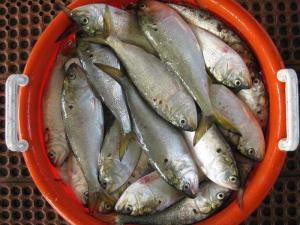Commission delays new approach to menhaden management
Fishery managers have opted to wait for the science to be finalized before managing Atlantic menhaden for its key role as a forage fish.
But some environmental groups say the commission overseeing the management of menhaden, or bunker, missed a historical opportunity by opting to follow the status quo.
“We were really disappointed with our commissioners for not supporting the best available science and the public input on the process,” said Chris Klarich, campaign manager at the Delaware Nature Society.
Representatives on the Atlantic States Marine Fisheries Commission Menhaden Management Board - three from each of the 15 East Coast states on the commission – had several options on how to manage and set quotas for menhaden. Environmentalists like Klarich hoped managers would choose the option that utilizes ecological reference points that consider menhaden's role in the marine food web as a vital food source for other fish, marine mammals and shorebirds.
“They're often called the most important fish in the sea because they're a forage fish that feeds on plankton, and they provide food for bluefish, whales and osprey,” Klarich said. He said most of the 160,000 public comments received on the proposed management favored a broader, ecological approach.
Instead, managers voted to continue managing menhaden as a single species, meaning they will not fully consider how its population numbers impact other species. However, the option chosen allows state and federal scientists to continue working on menhaden-specific ecological reference points, which are expected to be ready for peer review by 2019 at the earliest.
When that scientific data – which also means developing a complex computer model – is ready, the commission will review the information and adjust its management decisions accordingly, said Roy Miller, one of Delaware's three commissioners.
“I have confidence that what we did is responsible and was the right thing to do,” Miller said. “And in a couple of years, we'll be looking at the ecological reference points and we can re-evaluate where we are.”
Data show menhaden are not currently being overfished, but Klarich said environmentalists are concerned about the number of juvenile fish.
“Population numbers particularly for juveniles remain at near-historic lows,” he said. “Striped bass, bluefish and cod are all on the decline. There's a need for more ecological-based protection of menhaden.”
The Inland Bays provide nursery habitat for menhaden, a fish that also helps eat algae filling up the sensitive bay habitats, said Chris Bason, executive director at the Delaware Center for the Inland Bays.
“It's one of the most abundant and important fishes in the Inland Bays,” Bason said. “The more menhaden we have, the more big fish we have, the cleaner the water we have.”
He said he would have preferred commissioners take a precautionary approach by looking at menhaden's role in the whole ecosystem.
“But it's not the worst-case scenario here because it continues with the status quo for two years on a stock that is not overfished and is not being overfished,” he said. “At which point, the science will have been completed and my hope is then we can begin applying the ecological reference points.”
Miller said the commission also opted to increase the menhaden quota by 8 percent, which will allow fishermen to catch 216,000 metric tons – about 475 million pounds – annually. A single menhaden weighs about one pound or less.
Each Mid-Atlantic state on the commission is allowed to catch a certain percentage of that quota, with about 83 percent of the total allowable catch granted to Virginia. That's because Virginia is the last East Coast state with a reduction fishery – where menhaden are used to make other products such as Omega 3 protein, fertilizer and animal feeds, Miller said.
A similar plant existed along the shores of Lewes in the 1950s and 1960s, but now Delaware and other East Coast states use menhaden as bait for other species such as blue crabs and striped bass.
“The bait industry is becoming increasingly important, though,” Miller said, adding that the commission voted to give other states a minimal catch of 0.5 percent of the total.
In Delaware, which was granted 0.51 percent of the catch, fishermen can net about 2.3 million pounds of menhaden annually.
“That's more than we need,” Miller said. He said Virginia representatives weren't too pleased other states got a bigger piece of the pie, and that the commission voted to reduce the catch limit in the Chesapeake Bay from 87,000 metric tons to 50,000 metric tons.
“I think it's fair to say everyone is concerned about menhaden,” Miller said. “And so a lot of people are going to be watching what happens.”



























































